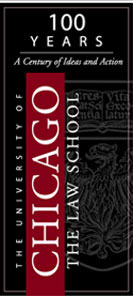|
THE BEST LAW CLASS EVER
The Class of 1960 had the good fortune to have as great a law
faculty as the world has ever known. We even had three years of
Karl Nickerson Llewellyn. Llewellyn was a unique lawyer. Some
think his specialty was commercial law. Those of us who knew him
well realize that his specialty was training lawyers. He was fiercely
proud of the profession. Every one of his classes contained some
anecdote or other information about ethical lawyering. He also
insisted that lawyers give back and become actively involved in
the profession. He and his wife, Soia Mentschikoff, who was equally
committed to training lawyers, were my mentors in law school.
I have pictures of both of them hanging in my office today. I
set this out only as an introduction to what was the greatest
single law class I ever attended.
Llewellyn had written The Common Law Tradition. The book, building
on his lectures at Columbia which formed The Bramble Bush, was
the consummate work on how American law, through the auspices
of great judges, developed to fit a growing and changing country.
His thesis was that there were three great periods of law. First,
the Grand Period, typified by Justice Marshall, where the court
in this country’s new experiment in democracy was struggling
to develop basic principles of justice and an independent judiciary.
The second period was the Formal Period, where lawyers sought
the definitive black letter law, believing that ultimately rules
could be found and articulated for all occasions. The third period
was the Neo-grand Period, where once again the great judges of
the early 20th century built upon the traditions of the Grand
Period and sought underlying principles of law to be applied against
ever-changing factual backgrounds. To Llewellyn, the greatest
judge, but by no means the only judge exemplifying the Neo-grand
Period, was Benjamin Nathan Cardozo. Every first year student
in the elements class was treated to stories about Cardozo and
his corrupt father, a Tammany Hall judge, and about how Cardozo
dedicated his life to the practice of law, in part to clear the
family name.
One day we arrived in class and the subject before us was the
common law tradition. Llewellyn came into class with a large briefcase.
He opened the briefcase and started taking out silver tableware.
This quickly drew the attention of the students.
Llewellyn began by talking about the Grand Period. He talked
about Justice Marshall. He talked about the judiciary reaching
out for principles that were utilitarian as well as fundamental.
He then picked up from his desk a large coin silver serving spoon.
He went on to describe the grace and beauty of the simple lines
of the colonial flatware, how its beauty was embodied in its simplicity,
and how it was designed to serve a utilitarian function.
He then returned to his lecture to talk about the ever-increasing
changes in the development of the Formal Period, with its ever-increasing
dependence on stare decisis. He talked about cases where judges
followed precedent into complicated and ill-conceived decisions,
getting to the point to where “the law is an ass.”
He then returned to his briefcase, took more silverware from it,
and showed the increasingly complicated handles parallel to our
country moving into the Victorian period. He finally pulled out
a table knife with a handle that was so convoluted and complicated
that it was totally grotesque, its own structure destroying any
thoughts of utilitarian beauty.
Back to the lecture. He talked about the great state court judges,
and then focused on Cardozo and his reaching back to first principles
and applying them to new factual circumstances. He reached down
into his briefcase and pulled out another piece of silver. Someone
in his family had purchased a set of Danish modern silver. He
pointed out that the frills were gone. There was the clean sweep
and grace of the handle, emphasizing the functional nature of
the utensil. Then, with a great arm gesture, he said, “This
typifies Cardozo, sweeping through the formality, the corruption
of the Formal Era and returning to first principles and utilitarian
construction.”
It’s been more than 43 years since this lecture, and I
haven’t re-read The Common-Law Tradition (although from
time to time, I must confess I take a peak at The Bramble Bush).
That single class, in all its detail, has stayed with me for all
these years and still provides a guide for my understanding of
the history of our common law. Whenever I prepare for oral argument
in an appellate case, I try to think of the clean sweep of the
Danish modern silver that will lead to the guiding principle upon
which my case should be decided. |



